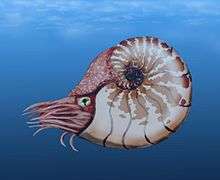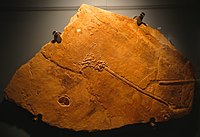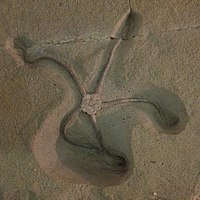Saltrio Formation
The Saltrio Formation is a geological formation in Italy. It dates back to the middle Sinemurian, and would have represented a pelagic or near-epicontinental environment, judging by the presence of marine fauna such as the nautiloid Cenoceras.[2][3] The Fossils of the Formation where described on the late 1880s and revised on 1960s, finding first marine biota, such as Crinoids, Bivalves and other fauna related to Epicontinental basin deposits.[4]
| Saltrio Formation Stratigraphic range: Early Sinemurian ~199–196 Ma | |
|---|---|
.jpg) Panoramic of Saltrio, with the “Salnova” quarry alt the background, where all the fossils have come from | |
| Type | Geological formation |
| Unit of | Calcari Selciferi Lombardi Unit |
| Underlies | Moltrasio Formation |
| Overlies | Tremona Formation |
| Lithology | |
| Primary | Limestone |
| Location | |
| Coordinates | 45.9°N 8.9°E |
| Approximate paleocoordinates | 33.1°N 14.8°E |
| Region | Lombardy |
| Country | |
| Type section | |
| Named for | Saltrio |
| Named by | Antonio Stoppani[1] |
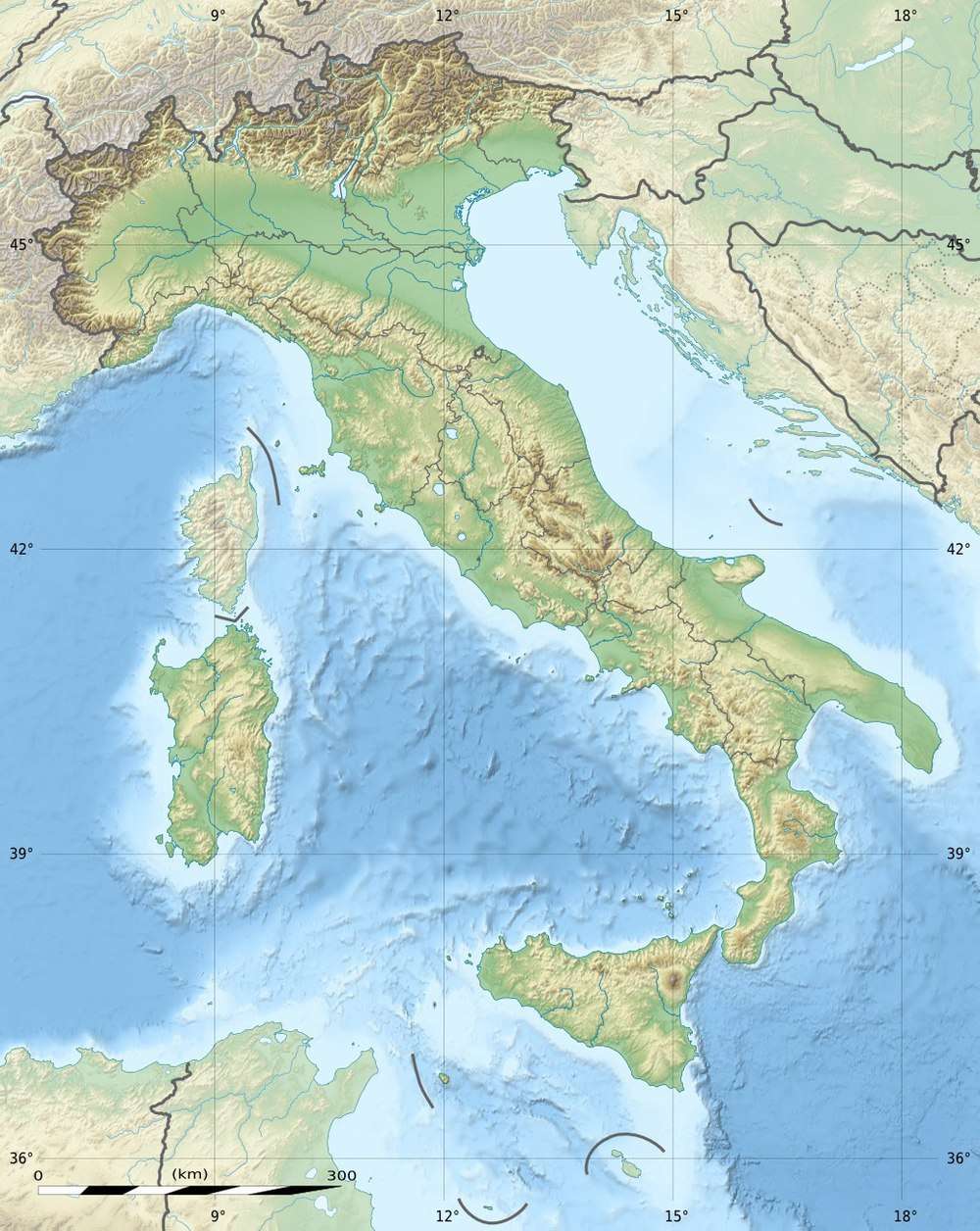 Saltrio Formation (Italy) 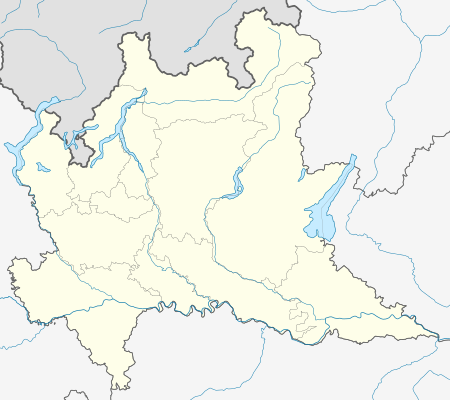 Saltrio Formation (Lombardy) | |
Environment
Since the beginning of the jurassic, from Hettangian to earliest Sinemurian on the western Lombardy Basin there was a notorious continental area, that was found yo be wider than previously thought, where it was developed a warm humid paleoclimate.[5] The Dinosaur Fossils foun on the Saltrio formation can have been translated from this area, or alternatively, the Arbostora swell (that was located ant the north of the Saltrio formation, on Switzerland).[6] This was an emerged structural high close to the Saltrio Formation, that caused a division between two near subsiding basins located at Mt. Nudo (East) and Mt. Generoso (West).[6] It was settled over a carbonate Platform linked with other wider areas that appear along the west to the southeast, developing a large shallow water gulf to the north, where the strata deposited was controlled by a horst and tectonic gaben.[6] There are also found several outcrops of the so-called “terra rossa” paleosoils, including at Castello Cabiaglio-Orino, a dozen of kilometers West of Saltrio.[7][8] This outcrops show that the emerged areas that on the Hettangian-Sinemurian where present where is located the modern Maggiore Lake were covered with forests, what was proven by the presence of large plant fragments on the Moltrasio Formation.[5] The plants have been recovered between the locations of Cellina and Arolo (eastern side of Lake Maggiore), from rocks that have been found to be coeval in age to the Saltrio Formation.[9] The Flora includes genera such as Bennettitales (Ptilophyllum), terrestrial Araucariaceae (Pagiophyllum), and Cheirolepidiaceae (Brachyphyllum), that developed on inland areas with dry-warm conditions.[9]
The ammonites from the Saltrio Formation allow the formation to be dated to the Early Sinemurian. Animals probably lived in emerged parts of carbonated platform or an area to the northwest, whose presence had never been established. In the early Sinemurian, the Arbostora swell became again a shallow open sea (ramp-slope), still surrounded South and South-West by emerged land. The dinosaur bones where washed on this period, flowed into a gulf of the Mt. Nudo basin, where they became fossilized. The latter possibility was suggested by Lualdi (1999), in which he analyzed the local geology based on the presence of terrestrial plants and terrigenous content (sands from igneous or metamorphic rocks exposed to sub-aerial erosion) in the limestones.[9] Terrestrial plants are essentially represented by leaves and small branches of Araucariaceans and Bennettitales, the typical flora of the early Mesozoic. However, plants and sand (which are not abundantly referred) can be carried by wind and ocean currents. Also, according to the most current paleogeographic maps, truly continental land located closer these Jurassic times lower were the Mountains of Sardinia, Corsica, distanced many tens of kilometers WNW.[10] Coeval and slightly younger in age, large dinosaurs, carnivorous and herbivorous, were present as show various footprints of the lower Jurassic (Hettangian-Sinemurian) in the province of Trento, around 160 kilometres (99 mi) east of Saltrio, which changed the traditional view of the palaeoenvironments and paleogeography of the region, considered a tropical sea with small islands of the atoll type.[11] Fossil footprints and tracks are preserved in tidal carbonates deposited in a relatively narrow carbonated platform in Trento, flanked to the east and west by relatively deep marine basins. Large theropods could not live in an atoll, since large areas had to be emersed to provide food and fresh water, and their herbivorous prey needed land with vegetation. The presence of vulcanodontids, cetiosaurs, primitive sauropods, heterodontosaurids, and scelidosaurs have been reported from the Calcari Grigi Group.[12]
"It is more likely that the Peri-Adriatic Platforms worked with temporary continental bridges that connected with Laurasia Gondwana in central Tethis, allowing migration between the two hemispheres and colonization of local coastal habitats." "During the marine transgressions, some of these lands were isolated, implicating genetic Mutations in their terrestrial faunas, with typical biological consequences, as endemism and possible dwarfism".[13]
Invertebrate fauna
Brachiopoda
| Rhynchonellata | |||||
|---|---|---|---|---|---|
| Genus | Species | Material | Location | Notes | Images |
|
Lobothyris punctata |
|
“Salnova” quarry.[3] |
A Rhynchonellatan, member of the family Lobothyrididae inside Terebratulida. Was identified originally as "Terebratula punctata". |
||
|
Liospiriferina rostrata |
|
“Salnova” quarry.[3] |
A Rhynchonellatan, member of the family Spiriferinidae inside Spiriferinida. Was identified originally as "Spiriferina haasi". |
||
|
Spiriferina expansa |
|
“Salnova” quarry.[3] |
A Rhynchonellatan, type member of the family Spiriferinidae inside Spiriferinida. It is a rather a complex series of specimens, whose classification is controversial. |
||
|
Cirpa variabilis |
|
“Salnova” quarry.[3] |
A Rhynchonellatan, member of the family Wellerellidae inside Rhynchonellida. Identified originally as "Rhynchonella variabilis". |
||
|
Rhynchonella acanthica |
|
“Salnova” quarry.[3] |
A Rhynchonellatan, member of the family Wellerellidae inside Rhynchonellida. Another series of Specimens of uncertain placement. |
| |
Bivalves
| Bivalvia | |||||
|---|---|---|---|---|---|
| Genus | Species | Material | Location | Notes | Images |
|
Calvaentolium hehlii |
|
“Salnova” quarry.[3] |
A Scallop, member of the family Pectinoidae inside Pectinida. It was identified originally as "Pecten (Pseudamusium) hehlii". |
||
|
|
“Salnova” quarry.[3] |
A Scallop, type member of the family Pectinoidae inside Pectinida. Mistake for other related genera on the deposit, it is among the most abundant local Scallops, altrougth the affinities with the genus Pecten haven't been proved. |
| |
|
|
“Salnova” quarry.[3] |
A Scallop, member of the family Pectinoidae inside Pectinida. It was identified as "Pecten (Chlamys) textorius". |
||
|
|
“Salnova” quarry.[3] |
A File Clam, member of the family Limidae inside Pectinida. Included on the Genus Plagiostoma, the status of the species is rather dubious. |
||
|
|
“Salnova” quarry.[3] |
A File Clam, member of the family Limidae inside Pectinida. Identified originally as "Lima (Plagiostoma) gigantea". |
| |
|
|
“Salnova” quarry.[3] |
A Clam, type member of the family Cardiniidae inside Carditida. Epicontinental deposits genus, rather abundant locally. Cardinia rugosa was first discovered on this formation. |
||
|
|
“Salnova” quarry.[3] |
A Clam, member of the family Cardiniidae inside Carditida. Rare locally, with some specimens considered dubious. |
||
|
|
“Salnova” quarry.[3] |
A Clam, type member of the family Astartidae inside Carditida. Some shells identified as Cardium probably belong to this genus. |
||
|
|
“Salnova” quarry.[3] |
A Clam, type member of the family Pleuromyidae inside Pholadida. Present on most of the deposits of the formation, with P. saltriensis being first discovered on the location. |
||
|
|
“Salnova” quarry.[3] |
A Clam, member of the family Pleuromyidae inside Pholadida. Rather rare and controversial genus. |
||
|
|
“Salnova” quarry.[3] |
A Clam, type member of the family Pholadomyidae inside Pholadomyida. Mostly incomplete specimens, what makes nearly impossible to assigante a concrete species. |
||
|
|
“Salnova” quarry.[3] |
A Clam, member of the family Lucinidae inside Lucinida. First identified on the formation. |
||
|
|
“Salnova” quarry.[3] |
A Clam, type member of the family Lucinidae inside Lucinida. Uncertain classification due to be based on fragmentary shell remains. |
||
|
|
“Salnova” quarry.[3] |
A Clam, member of the family Lucinidae inside Lucinida. Was first identified on the Formation. |
||
|
|
“Salnova” quarry.[3] |
A Clam, member of the family Lucinidae inside Lucinida. Identified originally as "Fimbria (Sphaeriola) sp.". |
||
|
|
“Salnova” quarry.[3] |
A Clam, member of the family Prospondylidea inside Pterioida. Is based on a few specimens |
||
|
|
“Salnova” quarry.[3] |
An Oyster, type member of the family Gryphaeidae inside Ostreida. Related with specimens of the Blue Lias Formation. |
| |
|
|
“Salnova” quarry.[3] |
An Oyster, type member of the family Ostreidae inside Ostreida. Rather Abundant genus, but lacks specimens enough complete for a formal identification. |
||
|
|
“Salnova” quarry.[3] |
An Pearl Oyster, member of the family Pteriidae inside Ostreida. Abundant and rather easy to identify. |
||
|
|
“Salnova” quarry.[3] |
An Mussel, member of the family Mytilidae inside Mytilida. Identified as the genus "Modiola", now junior synonym of Modiolus. |
||
Gastropods
| Gastropoda | |||||
|---|---|---|---|---|---|
| Genus | Species | Material | Location | Notes | Images |
|
|
|
A Sea Snail, type member of the family Pleurotomariidae inside Pleurotomarioidea. Relatively abundant genus, found specially on deposits with terrestrial debris input. |
| |
|
|
|
A Sea Snail, type member of the family Trochidae inside Trochoidea. Rather common, found associated with Echinoderm debris. |
||
Cephalopoda
| Cephalopoda | |||||
|---|---|---|---|---|---|
| Genus | Species | Material | Location | Notes | Images |
|
|
“Salnova” quarry.[18] |
A Nautilidan, type member of the family Cenoceratidae inside Nautilidae. The most abundant local cefalophod, Cenoceras was identified as member of the genus Nutilus originally. |
| |
|
|
|
An Ammonitidan, member of the family Arietitidae inside Psiloceratoidea. One of the main ammonites identified along the local dinosaur remains. |
||
|
|
|
An Ammonitidan, type member of the family Arietitidae inside Psiloceratoidea.The main Ammonite identified locally. |
||
|
|
|
An Ammonitidan, type member of the family Oxynoticeratidae inside Ammonitida. Not the most abundant, but rather common. |
||
Echinoderms
| Echinodermata | |||||
|---|---|---|---|---|---|
| Genus | Species | Material | Location | Notes | Images |
|
|
“Salnova” quarry.[18] |
An Sea lily, type member of the family Millericrinida inside Crinoidea.The main Crinoid identified locally. |
| |
|
|
“Salnova” quarry.[18] |
An Sea lily, type member of the family Pentacrinitidae inside Isocrinida. A Pelagic crinoid that live attached to washed wood. |
||
|
|
“Salnova” quarry.[18] |
An Echinoidean, type member of the family Miocidaridae inside Cidaroida. Related to epicontinental to pelagic waters. |
||
|
Palaeocoma[20] |
|
|
Mount Campo dei Fiori.[20] |
An Ophiuridan, member of the family Ophiodermatidae inside Ophiodermatina. Extant tropical species like Ophioderma are benthic predators and scavengers that show the same short spines seen in Palaeocoma.[20] |
|
Vertebrate fauna
Fish
| Osteichthyes | |||||
|---|---|---|---|---|---|
| Genus | Species | Material | Location | Notes | Images |
|
Osteichthyes Indeterminate |
|
“Salnova” quarry.[3] |
Outside Saltriovenator, no other vertebrate remains were found associated to this bone assemblage, except for one tooth and one jaw fragment pertaining to a bony fish.[3] |
||
Icthyosaurs
| Ichthyosaurians | |||||
|---|---|---|---|---|---|
| Genus | Species | Material | Location | Notes | Images |
|
|
Saltrio. |
A possible Neoichthyosaurian of the family Temnodontosauridae. Quoted on the 1880s, specimen that apparently have never been described or figured and whose present repository is unknown.[22] |
||
Pterosaurs
| Pterosaurs | |||||
|---|---|---|---|---|---|
| Genus | Species | Material | Location | Notes | Images |
|
"Pterodactylus" longirostris |
|
Saltrio. |
A possible Pterosaur. Quoted on the 1880s, specimen that apparently have never been described or figured and whose present repository is unknown.[22] |
||
Dinosaurs
| Theropods | |||||
|---|---|---|---|---|---|
| Genus | Species | Material | Location | Notes | Images |
|
“Salnova” quarry.[10] |
The oldest known Ceratosaur, falling outside Neoceratosauria, being sister taxa to the maroccan genus Berberosaurus. Saltriovenator is also the largest know Theropod of the Lower Jurassic. It probably was washed into the Sea.[3] Traces on the bones show that the dinosaur carcass remained exposed to the water-sediment interface for months or years, long enough to being first defleshed by mobile scavengers, then colonized by a microbial community that spanned the bone–water interface, which in turn attracted slow-moving grazers and epibionts.[3] |
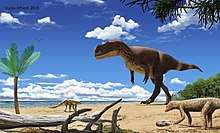 Saltriovenator on an ancient beach | ||
See also
- List of fossiliferous stratigraphic units in Italy
- List of dinosaur-bearing rock formations
References
- Stoppani A. (1857). Studi geologici e paleontologici sulla Lombardia. 461 pp. Tipografia Turati, Milano
- Weishampel, David B; et al. (2004). "Dinosaur distribution (Early Jurassic, Europe)." In: Weishampel, David B.; Dodson, Peter; and Osmólska, Halszka (eds.): The Dinosauria, 2nd, Berkeley: University of California Press. Pp. 532–534. ISBN 0-520-24209-2.
- Dal Sasso C, Maganuco S, Cau A. 2018. The oldest ceratosaurian (Dinosauria: Theropoda), from the Lower Jurassic of Italy, sheds light on the evolution of the three-fingered hand of birds. PeerJ 6:e5976 https://doi.org/10.7717/peerj.5976
- Vialli, G. S. (1963). Revisione della fauna di Saltrio: i Gastropodi, i Cephalopodi dibranchiati, i Briozoi, i Brachiopodi, gli Echinodermi, i Vertebrati. Tipografia del Libro.
- Jadoul, Flavio, Galli, M. T., Calabrese, Lorenzo, & Gnaccolini, Mario (2005). Stratigraphy of Rhaetian to Lower Sinemurian carbonate platforms in western Lombardy (Southern Alps, Italy): paleogeographic implications. Rivista Italiana di Paleontologia e Stratigrafia, 111(2), 285-303.
- Kalin, O., & DM, T. (1977).(1977): Sedimentation und Paläotektonik in den westlichen Südalpen: Zur triasisch-jurassischen Geschichte des Monte Nudo-Beckens. – Eclogae geol
- Leuzinger, P. (1925). Geologische Beschreibung des Monte Campo dei Fiori u. der Sedimentzone Luganersee-Valcuvia. E. Birkhäuser & Cie.
- Wiedenmayer, F. (1963). Obere Trias bis mittlerer Lias zwischen Saltrio und Tremona:(Lombardische Alpen); d. Wechselbeziehungen zwischen Stratigraphie, Sedimentologie u. syngenet. Tektonik. na.
- Lualdi, A. (1999). New data on the Western part of the M. Nudo Basin (Lower Jurassic, West Lombardy) Tubingen Geowissenschaftliche Arbeiten, Series A, 52, 173-176.
- Dalla Vecchia, F.M. 2001. A new theropod dinosaur from the Lower Jurassic of Italy, Saltriosaurus. Dino Press. 3, 81-87.
- AvAnzini, M., & Petti, F. M. (2008). Updating the dinosaur tracksites from the Lower Jurassic Calcari Grigi Group (Southern Alps, Northern Italy). Italian Ichnology. Proceedings of the Ichnology Session of Geoitalia 2007. Studi Trent. Sci. Nat., Acta Geol., 83, 289-301.
- Masetti, D., Claps, M., Giacometti, A., Lodi, P., & Pignatti, P. (1998). I Calcari Grigi della piattaforma di Trento (Lias inferiore e medio, Prealpi Venete). Atti Ticinensi di Scienze della Terra, 40, 139-183.
- Cristiano Dal Sasso: Dinosaurs of Italy. In: Comptes Rendus Palevol. Bd. 2, Nr. 1, 2003.
- Parona C.F. (1884). I brachiopodi liassici di Saltrio ed Arzo nelle Prealpi Lombarde. Memorie del Reale istituto lombardo di scienze e lettere, 15: 227-262.
- C. F. Parona. 1897. I Nautili del Lias inferiore di Saltrio in Lombardia. Bullettino della Società Malacologica Italiana 20:7-20
- C. F. Parona. 1890. I fossili del Lias inferiore di Saltrio in Lombardia. Atti della Società Italiana di Scienze Naturali 33:69-104
- Parona C.F. (1895). I fossili del Lias di Saltrio in Lombardia; Parte 2: Gasteropodi. Bollettino Società Malacologica Italiana, 18: 161-184.
- F. M. Dalla Vecchia. 2001. Terrestrial ecosystems on the Mesozoic peri-Adriatic carbonate platforms: the vertebrate evidence. VII International Symposium on Mesozoic Terrestrial Ecosystems. Asociación Paleontología Argentina, Publicación Especial 7:77-83
- Parona C.F. (1896b). Contribuzioni alla conoscenza delle ammoniti liasiche di Lombardia, Parte 1: Ammoniti del Lias inferiore di Saltrio. Mémoires de la Société Paléontologique Suisse, 23:1-45
- Jaselli, L. (2015). The Lower Jurassic (Early Sinemurian) ophiuroid Palaeocoma milleri in the palaeontological collection of the Museo di Storia Naturale “Antonio Stoppani”(Italy). Bollettino della Società Paleontologica Italiana, 54(3), 188.
- P. Lioy I coccodrilli fossili del Veneto Atti del Regio Istituto Veneto di Scienze Lettere e Arti (7), 7 (1896), pp. 753-783
- Delfino, M., & Dal Sasso, C. (2006). Marine reptiles (Thalattosuchia) from the early Jurassic of Lombardy (northern Italy). Geobios, 39(3), 346-354.
Further reading
- F. M. Dalla Vecchia. 2001. Terrestrial ecosystems on the Mesozoic peri-Adriatic carbonate platforms: the vertebrate evidence. VII International Symposium on Mesozoic Terrestrial Ecosystems. Asociación Paleontología Argentina, Publicación Especial 7:77-83
.jpg)
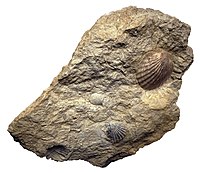
_1_(15206675956).jpg)
